
A dune is a landform composed of wind- or water-driven sand. It typically takes the form of a mound, ridge, or hill. An area with dunes is called a dune system or a dune complex. A large dune complex is called a dune field, while broad, flat regions covered with wind-swept sand or dunes, with little or no vegetation, are called ergs or sand seas. Dunes occur in different shapes and sizes, but most kinds of dunes are longer on the stoss (upflow) side, where the sand is pushed up the dune, and have a shorter slip face in the lee side. The valley or trough between dunes is called a dune slack.

Southwick Beach State Park is a New York State park that lies along an unusual stretch of sandy beach on the eastern shore of Lake Ontario. The park is 464 acres (188 ha) in size with a 3,500 foot (1,100 m) length of beach, and is visited annually by about 100,000 people. Immediately to the south is the Lakeview Wildlife Management Area, which extends the publicly accessible beach by several miles. They are in the Town of Ellisburg in Jefferson County, New York south of the lakeside community of Jefferson Park.

The Oregon Dunes National Recreation Area is located on the Oregon Coast, stretching approximately 40 miles (64 km) north of the Coos River in North Bend to the Siuslaw River in Florence, and adjoining Honeyman State Park on the west. It is part of Siuslaw National Forest and is administered by the United States Forest Service.
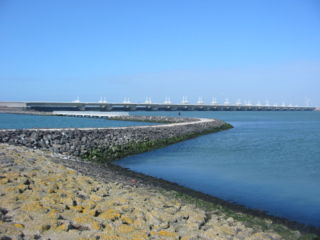
Coastal management is defence against flooding and erosion, and techniques that stop erosion to claim lands. Protection against rising sea levels in the 21st century is crucial, as sea level rise accelerates due to climate change. Changes in sea level damage beaches and coastal systems are expected to rise at an increasing rate, causing coastal sediments to be disturbed by tidal energy.
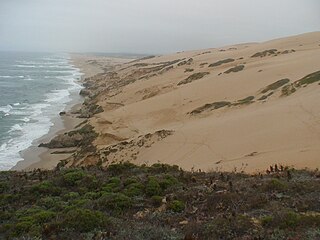
Guadalupe-Nipomo Dunes is the largest remaining dune system south of San Francisco and the second largest in the U.S. state of California. It encompasses an 18-mile (29 km) stretch of coastline on the Central Coast of California and extends from southern San Luis Obispo County to northern Santa Barbara County.

The Swan Coastal Plain in Western Australia is the geographic feature which contains the Swan River as it travels west to the Indian Ocean. The coastal plain continues well beyond the boundaries of the Swan River and its tributaries, as a geological and biological zone, one of Western Australia's Interim Biogeographic Regionalisation for Australia regions. It is also one of the distinct physiographic provinces of the larger West Australian Shield division.
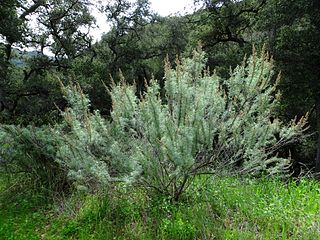
Artemisia californica, also known as California sagebrush, is a species of western North American shrub in the sunflower family.

Ammophila breviligulata is a species of grass native to eastern North America, where it grows on sand dunes along the Atlantic Ocean and Great Lakes coasts. Beachgrass thrives under conditions of shifting sand, sand burial, and high winds; it is a dune-building grass that builds the first line of sand dunes along the coast. Beachgrass is less vigorous in stabilized sand, and is only infrequently found further inland than the coastal foredunes. On the Atlantic coastline of North America, Ammophila breviligulata has been observed as far south as North Carolina, and is often planted in dune restoration projects. Ammophila breviligulata was introduced to the Pacific coast of North America in the 1930s. It is proving to be invasive, and is increasingly important to coastal ecology and development in Oregon, Washington, and British Columbia.

The Lanphere Dunes National Natural Landmark a unit of the Humboldt Bay National Wildlife Refuge Complex, is located in Humboldt County, California. The dune complex consists of the wave slope, fore dune, herbaceous and woody swales, coniferous and riparian forest, freshwater swamp, freshwater marsh, brackish marsh, salt marsh, and intertidal mudflats. The site exemplifies dunes succession.

In biogeography, a native species is indigenous to a given region or ecosystem if its presence in that region is the result of only local natural evolution during history. The term is equivalent to the concept of indigenous or autochthonous species. A wild organism is known as an introduced species within the regions where it was anthropogenically introduced. If an introduced species causes substantial ecological, environmental, and/or economic damage, it may be regarded more specifically as an invasive species.

Sand dune stabilization is a coastal management practice designed to prevent erosion of sand dunes. Sand dunes are common features of shoreline and desert environments. Dunes provide habitat for highly specialized plants and animals, including rare and endangered species. They can protect beaches from erosion and recruit sand to eroded beaches. Dunes are threatened by human activity, both intentional and unintentional. Countries such as the United States, Australia, Canada, New Zealand, the United Kingdom, and Netherlands, operate significant dune protection programs.

Lupinus nipomensis is a species of lupine known by the common name Nipomo Mesa lupine. It is endemic to the Guadalupe-Nipomo Dunes on the California Central Coast. Specifically, the plant is limited to the Guadalupe Dunes at the southern border of San Luis Obispo County. There are five to seven colonies growing in a strip of sand dunes measuring less than three square miles in area. These colonies are generally considered to make up a single population. The number of individual plants remaining has been observed to vary between 100 and 1,800, its abundance is not correlated to precipitation, is highly variable and exact mechanisms driving abundance unknown. This is a California state and federally listed endangered species.

New Zealand has 15,000 kilometres (9,300 mi) of coastline making it the 9th longest in the world. The coastline borders the Tasman Sea and the Pacific Ocean. The northern and southernmost points of the coastline on the two main islands are Surville Cliffs and Slope Point respectively.
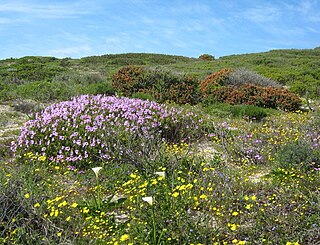
Cape Flats Dune Strandveld is an endangered vegetation type. This is a unique type of Cape Strandveld that is endemic to the coastal areas around Cape Town, including the Cape Flats.
A foredune is a dune ridge that runs parallel to the shore of an ocean, lake, bay, or estuary. Foredunes consist of sand deposited by wind on a vegetated part of the shore. Foredunes can be classified generally as incipient or established.

Arctotheca populifolia is a species of flowering plant in the family Asteraceae known by the common names beach daisy, Cape beach daisy, South African beach daisy, coast capeweed, dune arctotheca, beach pumpkin, sea pumpkin, dune cabbage, and in South Africa, seepampoen, tonteldoek, and strandgousblom. This species is native to coastal areas of the Cape Provinces and KwaZulu-Natal in South Africa, and of Mozambique. It was introduced to Australia and is now a common weed of coastal areas in New South Wales, South Australia, Tasmania, Victoria, and Western Australia.
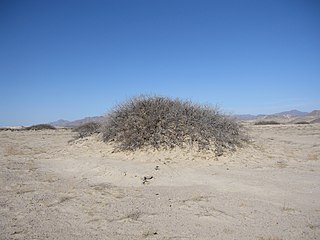
A nabkha, nebkha or nebka is a type of sand dune. Other terms used include coppice dune and dune hummock or hummocky dune, but these more accurately refer to similar, but different, sand dune types. Authors have also used the terms phytogenic hillock, bush-mound, shrub-coppice dune, knob dune, dune tumulus, rebdou, nebbe, and takouit.

Hulsig is a settlement and area of moorland and grey sand dunes in the Råbjerg Mile of the Skagens Odde peninsula, in northern Jutland, northern Denmark. The village lies along the Danish national road 40, to the southwest of the town of Skagen. The rugged heath area is protected under the title Hulsig Heath. Hulsig Station and Hulsig Church are located in the area. Hulsig is home to one of the country's few remaining flocks of dune sheep.
Omayed is a 75,800 ha UNESCO designated Biosphere Reserve in western Egypt in a sparsely populated region of coastal desert 80 kilometers west of Alexandria and 200 kilometers east of Matruh. It was designated as a biosphere reserve in 1981 and extended in 1998. The area includes four villages with a total 400 inhabitants. Habitats include coastal calcareous dunes, inland ridges, saline depressions, nonsaline depressions and inland plateau. The area provides important moss habitat. The Khashm El-Aish plateau in Omayed Protected Area (OPA) is home to 29 moss taxa recorded for the first time from Mediterranean coast, Egypt and 16 of them new records to the western Mediterranean coast. OPA includes 0.07% of Egypt's land mass but is home to more than 17 percent of its moss flora.

A psammophyte is a plant that grows in sandy and often unstable soils. Psammophytes are commonly found growing on beaches, deserts, and sand dunes. Because they thrive in these challenging or inhospitable habitats, psammophytes are considered extremophiles, and are further classified as a type of psammophile.


















